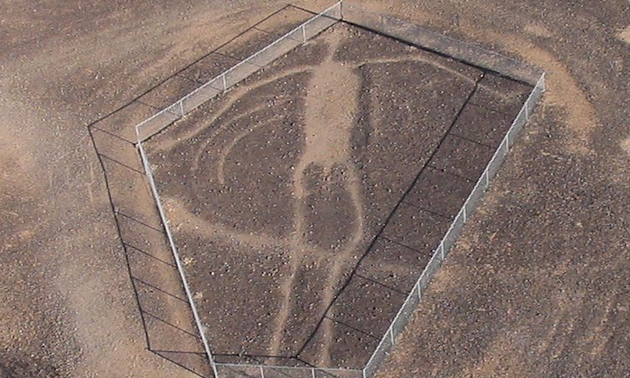As mentioned previously, due to the nature of the current phase in which we are archiving Barbara Drake’s collection, I have given myself much more freedom to engage with the specific materials. This past week, I found myself lost in the research Drake had compiled regarding ancient Indigenous history, and the artifacts that contributed to some of this understanding. Doing so, I learned a word I had never heard before– intaglio.
An intaglio, or a geoglyph, can be found prominently in the stretch of desert that connects Arizona to California. Their ancient construction resulted from the displacement of dark stones to reveal the light soil underneath, etchings that created a permanent symbol of prehistoric ancestries. According to an April 1989 issue of Arizona Highways these etchings are believed to be anywhere from 150, to 5,000 years old. Additionally, these etchings range anywhere from 20 feet in diameter, to over 150 feet. One intaglio, 75 miles west of Phoenix, measures an incredible 300 feet. These intaglios bear the resemblance of human figures, snakes, lizards, mountain lions and other geometric shapes. So, what does it all mean? Archaeologists mainly contend that these geoglyphs were intended to communicate with Native gods. The tone of communication exists on a speculative continuum ranging from praise and honor, to cries for help, imploring divine intervention to assuage the cruelty of an unrelenting and changing landscape. The aforementioned geoglyphs provide a peek into a time where the veil between spirituality and mortality might have been thinner.
These relics of a distant past, and their mystery, illustrate how much history was lost to colonialism. Not only did colonizers do their best to eradicate the powerful Native themselves, they simultaneously robbed future persons of enculturated sources for which clues to human history might exist. Due to the genocidal force that perpetuated colonialism, much of the primary, secondary or even tertiary source material regarding the spirituality of the ancient Native has been lost. Luckily, caretakers of culture and heritage, like Barbara Drake and her fellow Indigenous peoples, have preserved what is left and seek to reclaim what is yet to be discovered.

